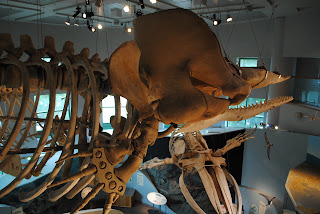As you know, readers, I am tackling Moby Dick this month. Herman Melville includes many didactic chapters about whales and whaling that break up the narrative. As I read some of these sections, I thought about Trouble's skeleton. Here is a passage for you to mull over with me:
"But it may be fancied, that from the naked skeleton of the stranded whale, accurate hints may be derived touching his true form. Not at all. For it is one of the more curious things about this Leviathan, that his skeleton gives very little idea of his general shape...the mere skeleton of the whale bears the same relation to the fully invested and padded animal as the insect does to the chrysalis that so roundingly envelopes it. This peculiarity is strikingly evinced in the head...It is also very curiously displayed in the side fin, the bones of which almost exactly answer to the bones of a human hand, minus only the thumb. This fin has four regular bone-fingers, the index, middle, ring, and little finger. But all these are permanently lodged in their fleshy covering, as the human fingers in an artificial covering."Here are some photos to illustrate Melville's point. The first photo is a picture of the sperm whale with all its flesh intact. Compare it to the skeleton of Trouble.
Melville, like other Romantics, believed that literature could be a vehicle to record history. Moby Dick teaches readers about the whaling industry and the limitations of scientific knowledge about whales during the 19th century. In addition to all these facts, Melville throws in a pretty good story. It's a built-in bonus (or perhaps I say "BONE-US" for Trouble's sake?)
Now go to your local museum and celebrate!




No comments:
Post a Comment